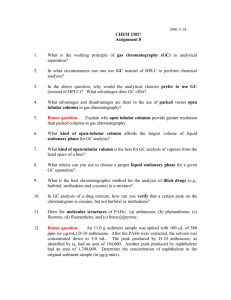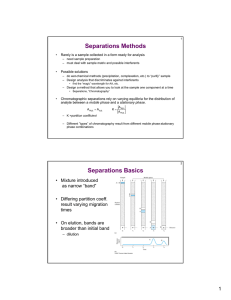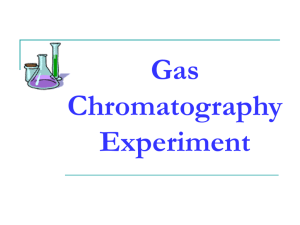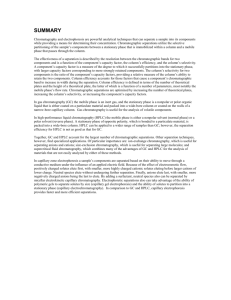CHEM 322 ... Spring 2015 ...
advertisement
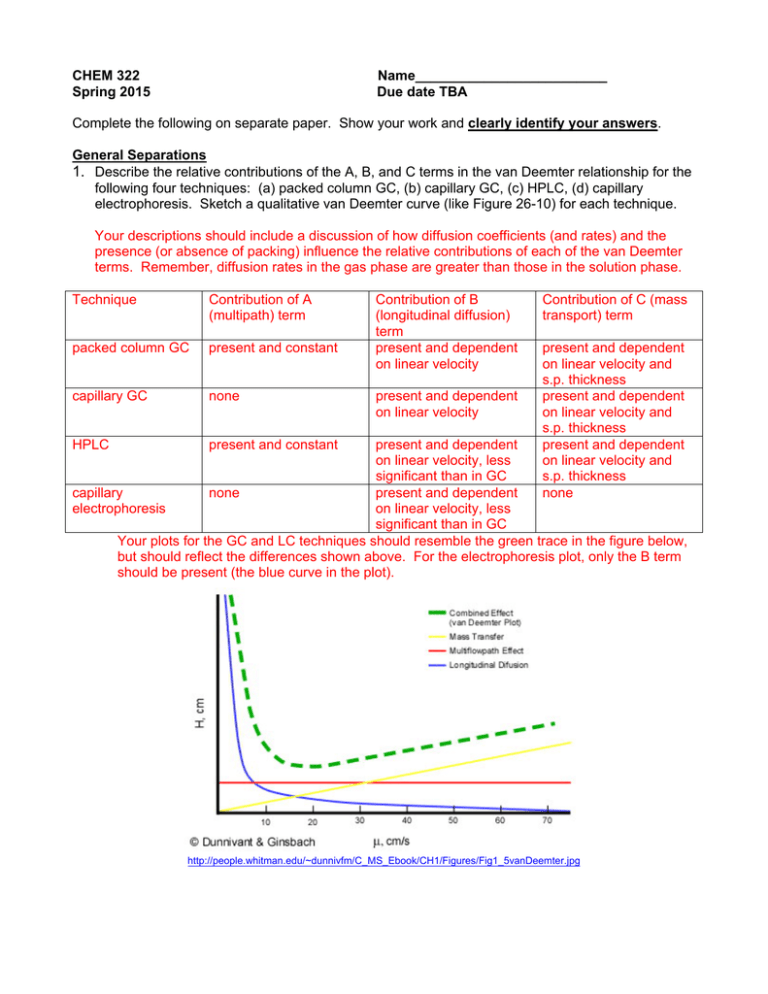
CHEM 322 Spring 2015 Name_________________________ Due date TBA Complete the following on separate paper. Show your work and clearly identify your answers. General Separations 1. Describe the relative contributions of the A, B, and C terms in the van Deemter relationship for the following four techniques: (a) packed column GC, (b) capillary GC, (c) HPLC, (d) capillary electrophoresis. Sketch a qualitative van Deemter curve (like Figure 26-10) for each technique. Your descriptions should include a discussion of how diffusion coefficients (and rates) and the presence (or absence of packing) influence the relative contributions of each of the van Deemter terms. Remember, diffusion rates in the gas phase are greater than those in the solution phase. Technique Contribution of A (multipath) term packed column GC present and constant capillary GC none HPLC present and constant Contribution of B (longitudinal diffusion) term present and dependent on linear velocity present and dependent on linear velocity Contribution of C (mass transport) term present and dependent on linear velocity and s.p. thickness present and dependent on linear velocity and s.p. thickness present and dependent on linear velocity and s.p. thickness none present and dependent on linear velocity, less significant than in GC capillary none present and dependent electrophoresis on linear velocity, less significant than in GC Your plots for the GC and LC techniques should resemble the green trace in the figure below, but should reflect the differences shown above. For the electrophoresis plot, only the B term should be present (the blue curve in the plot). http://people.whitman.edu/~dunnivfm/C_MS_Ebook/CH1/Figures/Fig1_5vanDeemter.jpg 2. How many theoretical plates must a column have to achieve a resolution of 1.5 between two peaks eluting at 8.0 and 8.2 min? From page 776 in our book, we find that: √ 4 We have values for each of the retention times and the resolution, so we can solve for N. 8.2 4 4 1.5 8.2 8.0 3. Why is dead volume more of a concern in gas chromatography than in liquid chromatography? Since diffusion coefficients (or rates) are higher in the gas phase than in the solution phase, dead volume would provide more significant opportunities for band broadening due to longitudinal diffusion in the gas phase (GC) than for a solution phase experiment (LC) 4. Consider the chromatogram below. For your convenience, the raw data for the chromatogram is available on our CHEM 332 website (under the “Homework” link) as an Excel file. a. Calculate the capacity factor (k’) for each peak. b. Calculate the resolution for each pair of adjacent peaks (A-B, B-C, C-D). c. Calculate the number of theoretical plates for peak D. From the chromatogram: tm= 1.32 min, retention times and peak widths are given below. Peak tr (min) tr' (min) w1/2 (min) w (min) A 2.76 1.44 0.06 0.24 B 3.07 1.74 0.06 0.18 C 3.28 1.95 0.07 0.27 D 4.33 3.01 0.08 0.30 a: k' 1.09 1.32 1.48 2.28 b: R c: N 1.46 0.93 3.71 3400 NOTE: your values may vary slightly depending on how you measured retention times and widths, but should be reasonably close to these. Gas Chromatography 1. What are the key benefits for using open tubular (capillary) columns as opposed to packed columns for GC? Why might you choose packed columns anyway? Open tubular columns tend to give more efficient separations (no multipath term). BUT, they can be more easily overloaded, leading to poor peakshape and resolution. Packed columns can generally handle larger sample sizes. 2. What is the effect of stationary phase film thickness on gas chromatograms? Stationary phase thickness impacts the C-term in the van Deemter relationship. As film thickness increases, diffusion into and out of the film requires longer times, generally increasing plate height and decreasing separation efficiency. 3. Consider the GC separation of water, n-propanol, 1,1-dichloropropane and n-propane on a carbowax column. The separation is run three times, once using a TCD, once with and FID, and once with an ECD. Sketch the expected chromatograms for each separation and describe the key differences in each chromatogram. Since carbowax is a polar stationary phase, we would expect the elution order to have the least polar compound elute first, with the most polar compound eluting last, assuming comparable boiling points (which is a good assumption). Therefore, the elution order should be n-propane→dichloropropane→propanol→water. The size of the peak corresponding to an analyte depends on the sensitivity of the detector for the compound of interest. Your chromatograms should reflect this. Detector TCD FID ECD n-propane sensitive sensitive insensitive dichloropropane sensitive sensitive sensitive propanol sensitive sensitive insensitive water sensitive insensitive insensitive Chromatogram Should have 4 peaks. Should have 3 peaks. Should have 1 peak (maybe a small one for propanol). 4. What is the purpose a retention index (also known as a Kovats index)? For the data below calculate the retention index for 2-hexene. t r’ Retention Time (minutes) air 0.542 n-pentane 2.88 2.338 n-hexane 4.51 3.968 2 hexene 3.77 3.228 Sample The Kovats index allows lab-to-lab comparison of results by referencing retention characteristics to those of n-alkanes run under the same conditions. log t r' U log t r' n RI 100 n N n log t r' N log t r' n Inserting values from above. N corresponds to hexane, n to pentane, and U to hexane, we find RI = 561 Liquid Chromatography 1. What is the purpose of a guard column in LC? How does it differ from a suppressor column? A guard column prevents materials that would irreversibly adsorb on the stationary phase from reaching the analytical column. Instead, those materials become trapped on the packing of the guard column, thus extending the life of the more expensive analytical column and helping to maintain the efficiency of the separation. A suppressor column is used to improve detection sensitivity in ion chromatography by converting conductive mobile phase ions like protons and hydroxide to water. They have little, if any, impact on separation efficiency. 2. Describe how an injection loop allows for improved precision for sample introduction. How does the autosampler on our HP1050 instrument function in a similar way? You should describe how the combination of an injection loop and 6-port valve helps to insure reproducible delivery of a specific amount of analyte onto the column. In an autosampler, the injection loop is replaced by a mechanical fluid metering device or syringe that draws a reproducible volume of solution into the injector. At an appropriate time, a 6-port valve directs mobile phase through the injector to deliver the sample to the column. 3. Consider the table below. Both fluorescence and electrochemical detection offer lower detection limits and wider linear ranges than absorbance detection, yet absorbance is still the most common LC detection mode. Suggest reasons why this might be the case. The key issue is that not all analytes fluoresce or are electrochemically active, therefore additional steps must be taken to apply these more sensitive detection schemes. The additional steps can often lead to poorer overall quality of the results of the method. 4. There is a movement toward using smaller particles (< 2 m) as stationary phases in LC. What benefits do using small particles have? What are the challenges in using smaller particles? Benefits: Faster, more efficient separations, smaller sample volumes, smaller flow rates, decreased solvent consumption. Challenges: Higher back pressures, more stringent stationary phase preparation requirements. Capillary Electrophoresis 1. Why does pH affect the separation of amino acids by electrophoresis? Since amino acids are amphiprotic, pH will impact the charge state on the amino acid. At low pH, the amino acid will be positively charged, at high pH, it will be negatively charged and at a pH near the isoelectric point it will be effectively neutral. Since electrophoretic mobility depends on charge, these pH changes will lead to mobility changes. 2. Explain how micellar electrokinetic chromatography combines electrophoretic and chromatographic separations principles. Why is the MEKC micelle called a “pseudostationary phase”? The presence of micelles introduces an environment into which analytes can partition. The interior of the micelle will tend to be less polar than the buffer, so less polar analytes can migrate into the micelle and have their effective mobility changed by this interaction. This is similar to the types of interactions between analyte and stationary phase in chromatography. The general movement of micelles and analytes is still driven by electrophoretic principles. The term pseudostationary phase refers to the stationary phase type partitioning in these moving (NOT stationary) micelles. 3. Describe how electroosmotic flow might be intentionally “turned off” during an electrophoretic separation. Why might someone want to do this? Electroosmosis can be turned off by coating the walls of the capillary to prevent the formation of deprotonated silanol groups. This can be done by reaction with an alkylated chlorosilane. Elimination of electroosmosis leaves electrophoretic flow as the only means of mass transport. This can allow more efficient separations of either cations or anions, but not both at the same time. 4. Capillary electrophoretic separations have the potential (no pun intended) to give very efficient separations, when compared to GC and LC. Why is this the case? Since there are is no stationary phase, the only phenomenon that limits resolution is longitudinal diffusion. Therefore, it is potentially much easier to optimize a CE separation than and LC or GC separation. The flat flow profile present in CE also leads to less band spreading than the parabolic flow profile in a pressure-driven system.

